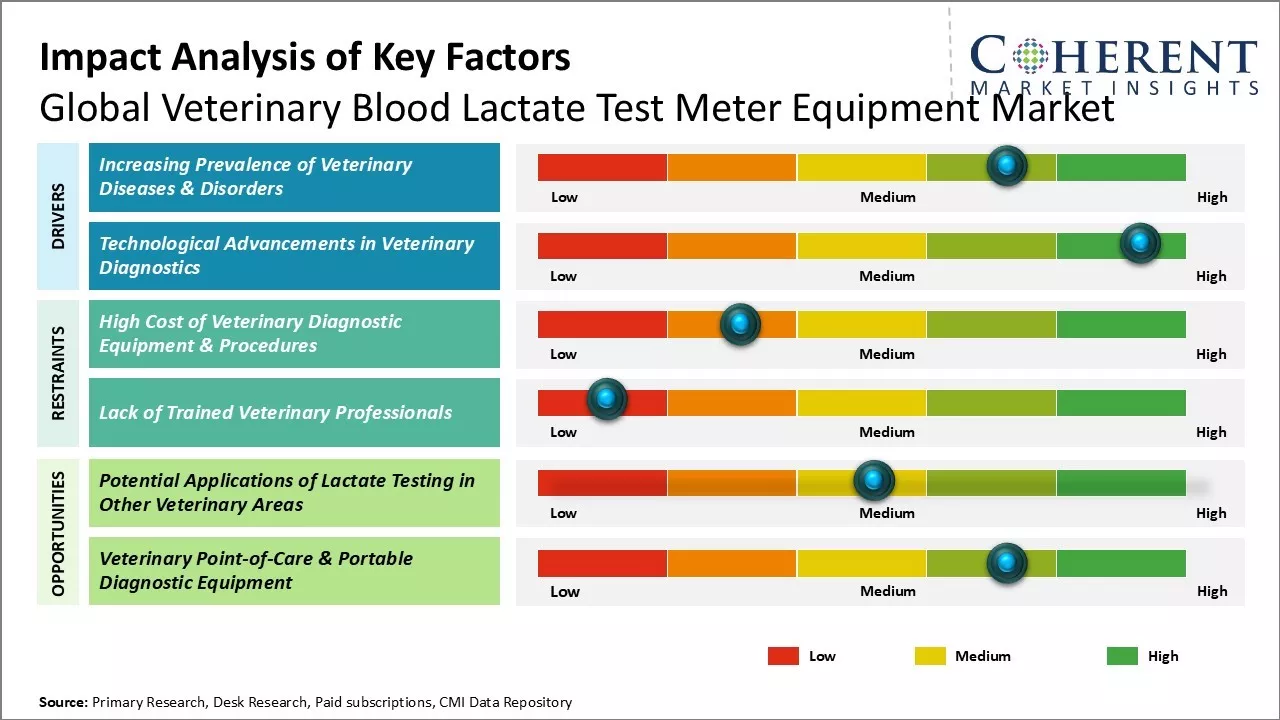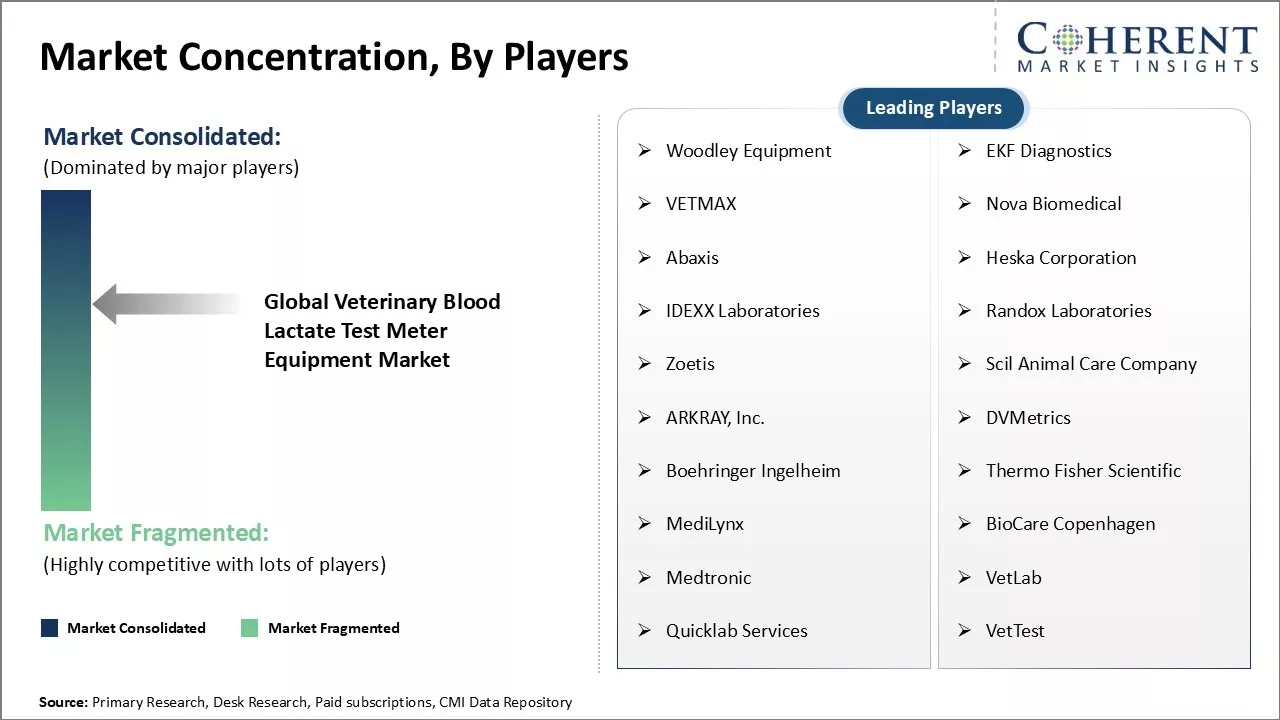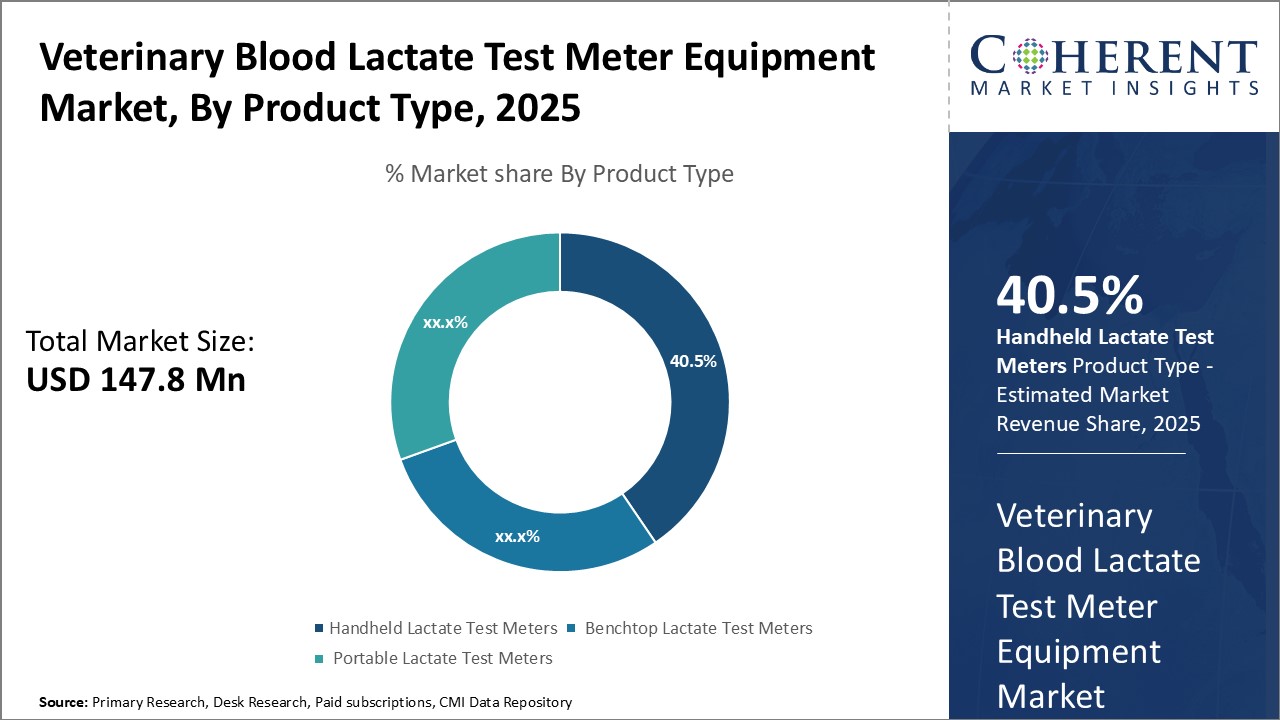Veterinary Blood Lactate Test Meter Equipment Market Size and Trends
The Global Veterinary Blood Lactate Test Meter Equipment Market is estimated to be valued at USD 147.8 Mn in 2025 and is expected to reach USD 215.2 Mn by 2032, exhibiting a compound annual growth rate (CAGR) of 5.5% from 2025 to 2032.

Discover market dynamics shaping the industry: Download Free Sample
The global veterinary blood lactate test meter equipment market is witnessing significant growth over the past few years driven by rising pet adoption, increasing veterinary healthcare expenditure, and growing prevalence of various animal diseases. Additionally, ongoing technological advancements in veterinary diagnosis devices along with increasing awareness about animal health among pet owners propel the need for accurate and quick lactate testing equipment for pets. The advanced features of these test meters including portability, easy to use interfaces, and quick result ensure more acceptance among veterinarians. The trend is expected to continue in coming years as developed regions show high potential while developing markets will also contribute significantly to the global market expansion.
Market Driver - Increasing Prevalence of Veterinary Diseases & Disorders
The prevalence of various diseases and disorders among companion animals as well as livestock has been on the rise in the recent years. Pets are living longer lives owing to improvements in veterinary care and owners are also willing to spend more on advanced diagnostics and treatment for their beloved animals. This has led to increased chances of various age-related ailments and chronic medical conditions among pets. According to experts, diseases like diabetes, various types of cancer, and kidney failure are becoming more common in dogs and cats today as compared to a few decades back. Early and accurate diagnosis plays a vital role in effective management of such diseases. Point-of-care diagnostic tools like lactate meters allow veterinarians to quickly test for disorders like sepsis and make timely clinical decisions. For livestock animals, the threat of infectious diseases persists. Farmers need to regularly monitor their herd health to curb outbreaks and minimize economic losses. Metabolic dysfunctions are also commonly reported in high yield dairy cows. Portable lactate analyzers empower veterinarians with an affordable and reliable way to conduct on-farm testing for conditions indicated by abnormal blood lactate levels. This helps initiate prompt treatment and control the spread of illness among livestock. The growing veterinary case load coupled with demand for advanced yet affordable diagnostics from pet owners as well as livestock farmers is proving beneficial for the lactate test meter market.
Market Concentration and Competitive Landscape

Get actionable strategies to beat competition: Download Free Sample
Technological Advancements in Veterinary Diagnostics
Veterinary medicine has witnessed tremendous enhancements in diagnostic equipment and methods over the years. Manufacturers are consistently innovating and introducing more advanced, user-friendly and multifunctional devices. Point-of-care testing solutions are gaining popularity as they facilitate quick decision making and patient monitoring directly at the clinical site. Portable blood analyzers that can measure critical parameters like lactate using just a small blood sample provide instant results to the practitioner. This saves time otherwise spent on sending samples to an external lab and waiting for the report. Moreover, portable devices enable conducting field-based testing for large or farm animals that cannot be easily transported.
In addition, some new lactate meters feature wireless connectivity options. Test data and patient records can be digitally transferred and stored on laptops or dedicated diagnostic software for future reference and analysis. This promotes telehealth and easier sharing of information between different practitioners involved in an animal's care. Accuracy of results from handheld analyzers is also improving steadily with ongoing technical refinements. Overall, constant innovations are making veterinary diagnostics more sophisticated as well as convenient to use. This encourages practitioners as well as pet owners and farmers to adopt novel devices like integrated lactate test meters.
Key Takeaways from Analyst:
The global veterinary blood lactate test meter equipment market is expected to witness steady growth over the forecast period driven by rising pet adoption and increasing awareness about animal health. The growing companion animal population has pushed the demand for advanced preventive care and timely diagnostics. Portable and easy-to-use lactate meters allow veterinarians to quickly monitor animal health conditions and improve treatment outcomes. North America presently dominates the market due to high pet care expenditures and availability of advanced veterinary healthcare facilities in the region. However, the Asia Pacific market is likely to expand at the fastest pace due to rising livestock population, growing meat consumption, and improving animal welfare standards in countries such as India and China.
A potential restraint to market growth could be the higher costs associated with veterinary blood lactate equipment compared to conventional diagnosis methods. This might limit adoption rates among low-income animal owners. Lack of trained professionals in developing regions also impedes market expansion. However, ongoing research & development of affordable and user-friendly meters could help address these challenges. New product launches with enhanced functionality, connectivity, and compact sizes are further expanding the application scope of lactate meters. Collaborations between key players and veterinary hospitals/clinics are also helping to penetrate untapped regional landscapes.
Market Challenge - High Cost of Veterinary Diagnostic Equipment & Procedures
One of the major challenges for the global veterinary blood lactate test meter equipment market is the high cost of veterinary diagnostic equipment and procedures. Many pet owners find the cost of advanced veterinary diagnostic tools and laboratory tests to be prohibitively expensive. This is because veterinary diagnostic devices often use similar scientific technologies as human medical equipment but are produced in lower volumes, leading to higher per-unit costs. Additionally, small animal veterinary practices often do not have the budget or space for large capital equipment purchases. The high prices of veterinary lactate meters and lactate testing cartridges can put the equipment and ongoing testing costs out of reach for general small animal practitioners serving clientele with multiple pets. High costs reduce accessibility to rapid lactate testing and limit the ability of veterinarians to incorporate point-of-care lactate analysis into their treatment protocols as often as needed. This represents a challenge to the growth and adoption of veterinary lactate meter technology.
Market Opportunity - Potential Applications of Lactate Testing in Other Veterinary Areas
One of the major opportunities for the global veterinary blood lactate test meter equipment market is the potential applications of lactate testing in other veterinary areas beyond anesthesia monitoring and performance evaluations. Point-of-care lactate analysis provides a rapid, inexpensive indication of whole-body energy metabolism, and oxygen delivery that could benefit equine, livestock, and exotic/zoo animal medicine. Lactate testing may have diagnostic and treatment monitoring applications for conditions like colic, capture myopathy, laminitis, neonate health issues, and more. There is also potential to use lactate testing to evaluate responses to medications, rehydration protocols, or other therapeutic interventions across multiple veterinary species. If veterinary lactate meters can demonstrate reliable, user-friendly functionality with different animal species, it may open new market opportunities and expand the reach of point-of-care lactate technology within the global veterinary medicine industry.

Discover high revenue pocket segments and roadmap to it: Download Free Sample
By Product Type - Convenience and Mobility Drive Adoption of Handheld Devices
In terms of product type, the handheld lactate test meters segment is expected to contribute the highest share of the market with 40.5% in 2025 owing to their convenience and portability. Being handheld devices, they offer unmatched mobility and allow for quick on-site testing of animal blood lactate levels without needing to transport samples to a lab. This is a major advantage, especially for veterinarians working in the field or at livestock farms. The handheld nature makes it easy to test multiple animals rapidly and get instant results to help make timely medical decisions.
The compact, lightweight design of handheld meters also means they take up very little storage space and are simple to carry around during farm/home visits or emergency situations. This contributes to their popularity among veterinary professionals. The ease of use and small form factor has boosted adoption among individual pet owners as well who want to monitor their companion animals' health at home. No additional equipment or infrastructure is required to operate handheld meters, reducing set up efforts and costs.
Moreover, advances in miniaturization have enabled handheld devices to offer lab-grade accuracy and reliability despite their compact size. New built-in features like memory storage, wireless connectivity and touchscreen interfaces have enhanced usability. Battery life has also improved significantly such that a single charge can power testing of dozens of samples – a big advantage over conventional bench top analyzers. Overall, the user-friendly design and portability aspects have made handheld models the product of choice for point-of-care lactate testing.
By Sample Type - Whole Blood Samples Dominate Due to Simplicity
In terms of sample type, the whole blood segment is expected to contribute the highest share with 43.62% in 2025 owing to the simplicity of sample collection and testing. Drawing and analyzing a whole blood sample is much more convenient and less cumbersome than obtaining plasma or serum. No centrifugation or separation steps are required prior to analysis with whole blood, streamlining the overall workflow. This is beneficial especially in situations where timely results are crucial, such as during medical emergencies.
Veterinarians and other animal healthcare personnel prefer whole blood testing due to the ease of extracting a small sample directly from veins or arteries. Moreover, certain animal species may have very low blood volumes, necessitating tests that use minimal sample sizes. Whole blood cater to this need well as only tiny amounts are sufficient. The non-invasive collection method causes little distress to animals.
From the user perspective, meters optimized for whole blood are very simple to operate - samples can be applied directly onto test strips or cartridges without any preprocessing. This minimizes training needs and the potential for errors. Meter kits marketed for whole blood analysis also tend to be more affordable than those requiring plasma/serum. Altogether, the advantages of reduced complexity and immediate result turnaround have contributed to the lead position of whole blood in the market.
By Animal Type - Companion Animals Lead with Growing Pet Healthcare Needs
In terms of animal type, the companion animals segment is estimated to dominate the highest share of the market with 48.5% in 2025 driven by rising pet healthcare expenditures and increasing recognition of animal health issues. Dogs and cats are the most popular pet species kept for companionship worldwide. However, they also have higher risk of certain injuries and illnesses due to factors like obesity, inactivity or advanced age.
Monitoring metabolic functions and early disease detection have become important aspects of companion animal healthcare. Lactate testing provides useful insight into conditions like seizures, infections, trauma injuries and exercise intolerance. Pet owners are increasingly willing to spend on preventive care and have come to value point-of-care testing devices. Lactate meters complement portable blood glucose monitors which are already widely used for diabetic pets.
Veterinary practices also see more companion animal patients annually. This has amplified demand for POC diagnostic tools to enhance efficiency and provide added services. Furthermore, pet insurance growth is supporting routine screening and management of chronic diseases. With continued humanization of pets, the companion animal segment will continue dominating the lactate meter market backed by owners' commitment to providing the best care. Advocacy efforts by animal welfare groups have further bolstered this behavior.
Regional Insights

Need a Different Region or Segment? Download Free Sample
North America currently dominates the global veterinary blood lactate test meter equipment market with an estimated share of 40.8% in 2025. The U.S. is home to some of the largest veterinary healthcare companies in the world with a strong focus on research and development of advanced diagnostic equipment. With the highest pet ownership rates globally and growing expenditure on pet healthcare, the U.S. market provides lucrative growth opportunities for lactate meter manufacturers. Several veterinary clinics and hospitals in the region have started using lactate testing routinely to monitor recovery from anesthesia and surgery or to detect sepsis at an early stage. This has boosted demand for reliable and easy-to-use lactate meters.
Asia Pacific is poised to emerge as the fastest-growing regional market for veterinary blood lactate test meter equipment over the next five years. Rapid urbanization and rising pet adoption, especially in China, India, and other Southeast Asian countries, is driving growth. Many regional players are entering partnerships with global veterinary diagnostics vendors to access new technologies and expand their product portfolios. This is increasing the accessibility and availability of veterinary diagnostic equipment including lactate meters across Asia Pacific nations. Additionally, growing livestock industry and awareness about animal welfare is pushing farm owners and vets to incorporate lactate testing more widely to monitor exercise tolerance in performance animals. Overall, growing veterinary healthcare spending propelled by economic development is expected to sustain the high growth momentum of the Asia Pacific market.
Market Report Scope
Veterinary Blood Lactate Test Meter Equipment Market Report Coverage
| Report Coverage | Details | ||
|---|---|---|---|
| Base Year: | 2024 | Market Size in 2025: | USD 147.8 Mn |
| Historical Data for: | 2020 To 2024 | Forecast Period: | 2025 To 2032 |
| Forecast Period 2025 to 2032 CAGR: | 5.5% | 2032 Value Projection: | USD 215.2 Mn |
| Geographies covered: |
|
||
| Segments covered: |
|
||
| Companies covered: |
Woodley Equipment, EKF Diagnostics, VETMAX, Nova Biomedical, Abaxis, Heska Corporation, IDEXX Laboratories, Randox Laboratories, Zoetis, Scil Animal Care Company, ARKRAY, Inc., DVMetrics, Boehringer Ingelheim, Thermo Fisher Scientific, MediLynx, BioCare Copenhagen, Medtronic, VetLab, Quicklab Services, and VetTest |
||
| Growth Drivers: |
|
||
| Restraints & Challenges: |
|
||
Uncover macros and micros vetted on 75+ parameters: Get instant access to report
Veterinary Blood Lactate Test Meter Equipment Industry News
- In August 2024, EKF Diagnostics launched Lactate Scout Vet, a new handheld lactate analyzer designed for veterinary use. Building on proven technology originally developed for elite sports, this device allows species-specific testing for dogs, horses, pigs, and cattle. It provides accurate lactate measurements in 10 seconds from a small 0.2 µL capillary blood sample.
*Definition: The Global Veterinary Blood Lactate Test Meter Equipment Market involves equipment used by veterinarians to test the level of lactate in an animal's blood. Lactate levels can indicate issues like respiratory distress, shock, or infection needing urgent treatment. The equipment allows for quick, non-invasive bedside testing and includes handheld meter devices, testing strips or cassettes, control solutions, and other accessories. Results are displayed digitally to help vets assess an animal patient's condition and determine appropriate care.
Market Segmentation
- By Product Type Insights (Revenue, USD Mn, 2020 - 2032)
-
- Handheld Lactate Test Meters
- Benchtop Lactate Test Meters
- Portable Lactate Test Meters
- By Sample Type Insights (Revenue, USD Mn, 2020 - 2032)
-
- Whole Blood
- Plasma
- Serum
- By Animal Type Insights (Revenue, USD Mn, 2020 - 2032)
-
- Companion Animals
- Livestock Animals
- Exotic Animals
- By End user Insights (Revenue, USD Mn, 2020 - 2032)
-
- Veterinary Hospitals
- Veterinary Clinics
- Research Laboratories
- Diagnostic Laboratories
- By Regional Insights (Revenue, USD Mn, 2020 - 2032)
-
- North America
- U.S.
- Canada
- Latin America
- Brazil
- Argentina
- Mexico
- Rest of Latin America
- Europe
- Germany
- U.K.
- Spain
- France
- Italy
- Russia
- Rest of Europe
- Asia Pacific
- China
- India
- Japan
- Australia
- South Korea
- ASEAN
- Rest of Asia Pacific
- Middle East
- GCC Countries
- Israel
- Rest of Middle East
- Africa
- South Africa
- North Africa
- Central Africa
- North America
- Key Players Insights
- Woodley Equipment
- EKF Diagnostics
- VETMAX
- Nova Biomedical
- Abaxis
- Heska Corporation
- IDEXX Laboratories
- Randox Laboratories
- Zoetis
- Scil Animal Care Company
- ARKRAY, Inc.
- DVMetrics
- Boehringer Ingelheim
- Thermo Fisher Scientific
- MediLynx
- BioCare Copenhagen
- Medtronic
- VetLab
- Quicklab Services
- VetTest
Share
Share
About Author
Manisha Vibhute is a consultant with over 5 years of experience in market research and consulting. With a strong understanding of market dynamics, Manisha assists clients in developing effective market access strategies. She helps medical device companies navigate pricing, reimbursement, and regulatory pathways to ensure successful product launches.
Missing comfort of reading report in your local language? Find your preferred language :
Transform your Strategy with Exclusive Trending Reports :
Frequently Asked Questions
EXISTING CLIENTELE
Joining thousands of companies around the world committed to making the Excellent Business Solutions.
View All Our Clients
